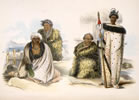Tokaanu
Settlement at the south end of Lake Taupō, 5 km west of Tūrangi. Before Tūrangi was developed in the 1960s, Tokaanu was the major settlement at the south end of the lake. It remains home to a sizeable Māori population and was also a mission settlement in the 19th century. The armed constabulary post later became a hotel, which catered for travellers between Whanganui and Taupō. Hot pools are still an attraction.
The small bush-covered cone of Maunganamu (sandfly hill) is east of the town. The environment round Tokaanu was transformed in the 1960s when tailrace pipes were built to the Tokaanu power station, on the road between Tokaanu and Tūrangi.
A switched-on priest
Adrian Langerwerf was a Catholic missionary at Tokaanu and Waihī from 1905. Keen to see Ngāti Tūwharetoa prosper materially as well as spiritually, he organised volunteers to build a hydroelectric plant which would supply power to a butter factory he’d helped start. By 1919, the factory had electricity, and – unlike most of rural New Zealand – every home in Waihī was said to have it too.
Waihī
Māori settlement 9 km north-west of Tūrangi, at the end of a private road. Waihī is an important centre for Ngāti Tūwharetoa and home of the Te Heuheu family. In the 1850s it was a base for Anglican missionary endeavour in the central North Island. The distinctive steepled, white-painted Catholic church, dating from 1889, has stained-glass windows showing a Māori Jesus and Mary, and is much photographed.
The settlement sits at the base of Kākaramea mountain. Hipaua, a geothermal area on the lower slopes, is visible from Waihī, and a waterfall completes the descent of the Waihī Stream into the lake. A landslide from Hipaua in 1846 buried the settlement of Te Rapa, killing Tūwharetoa paramount chief Mananui Te Heuheu and many others. The American writer and angler Zane Grey visited in the 1920s. Viewing Waihī from the lake, he wrote that ‘the red-roofed white houses … stood out clearly against the green’. 1
Pūkawa
Settlement on the south-west shore of Lake Taupō, where the missionary T. S. Grace set up a station in 1854 – later abandoned when war broke out in Waikato in 1863. An inter-tribal hui (meeting) at Pūkawa in 1856 chose Pōtatau Te Wherowhero of Waikato as the first Māori king.
Today Pūkawa has many holiday houses. In 2006 a hui was held to commemorate the 150th anniversary of the 1856 meeting.
Omori, Kuratau and Whareroa
Holiday settlements north of Tokaanu on the south-west shores of Lake Taupō. Kuratau is at the outlet of the Kuratau River. Upstream, a dam for a hydroelectric power station has created Lake Kuratau. Further inland is Kuratau Junction, a former sawmilling settlement.



